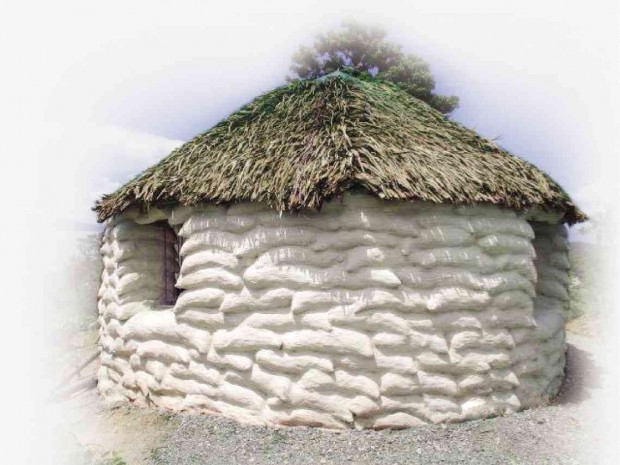
KOORNSTRA’S eco-friendly house, built in September last year and completed in 8 weeks, withstood Typhoon “Nona” which hit Mindoro in December last year. KEES KOORNSTRA/CONTRIBUTOR
Dutch national Kees Koornstra finds it amusing that his friends, Filipinos and expatriates alike, are calling him the hobbit.
This started, he said, when he moved in October to his new home in Puerto Galera, Oriental Mindoro.
His “hobbit hole,” the only structure on top of a hill in Barangay Balatero, passes for something taken out of Middle Earth in Lord of the Rings.
It looks like a twin igloo with walls made of sand-filled sacks and its roof of nipa palm. The house uses no electricity except that from solar panels and the water is collected mainly from the rain.
“It’s my house. I live in it,” Koornstra said with pride.
Koornstra, 62, used to own a boatyard in Holland. He used to travel around the globe on a yacht until the former sailor decided to settle in the tourist town of Puerto Galera in 2000.
He, of course, had lived in a concrete house elsewhere and in his first four years in Puerto Galera. But he had always wanted to move into a sandbag home.
A friend, a Mexican-American Christian pastor who lives in Puerto Galera and married to a Filipino woman, lent him land in the uphill village about 500 meters from the main road.
Koornstra learned about sandbag technology in the Internet and, with two helpers, started to build the house himself in September last year. It was finished in eight weeks.
The house is made of stacked up sandbags nailed to small pieces of wood to keep the pile in place. The first dome, about 6 meters (20 feet) in diameter, serves as the living room while the next dome, about 4.5 meters (15 feet) in diameter, is where the bedroom, toilet and the shower are. Both domes rise to as high as 4 meters (14 feet).
“When it was still being constructed, I thought it was ugly. But I was surprised when I saw it after,” said Koornstra’s Filipino girlfriend, Retchie dela Peña, 28.
The walls were plastered before they were painted with yellow and lavender. The kitchen was painted yellow and the ceiling, green.
But what made the structure even “cooler” is the ability of its 20-inch thick walls to deflect heat. “We don’t need an electric fan or an air-conditioner anymore,” she said.
Koornstra said he spent about P100,000 for the house and another P50,000 to set up a three-panel solar energy system. He also owns a 1,000-liter tank to collect rainwater, but fetches drinking water from his closest neighbor about 150 meters from his home.
“It’s not cheap (the solar panels), but compared with my electric bills before, I think I will earn back my investment in seven years,” said Koornstra. “And I never have to deal with brownouts anymore,” he added.
Koornstra said his sandbag home is not only less expensive, but also weather-resilient.
It survived without a crack when a 5.8-magnitude quake hit Puerto Galera in October last year, just days after the house was completed. It also survived, except for “a little wet floor,” when Typhoon “Nona” (international name: Melor) hit Oriental Mindoro in December last year devastating practically the whole of Mindoro island.
Koornstra’s sandbag shelter is so far unique in the community but he and his pastor friend are planning to build similar shelters to serve as houses and a church for Mangyan families in the town.
“It’s doable,” he said.
And to those who doubt him, he has this message: Come and see for yourself.